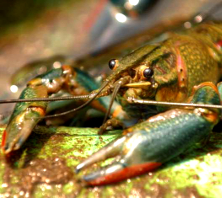Outgoing crayfish concern scientists
 A new study finds crayfish can be affected by antidepressants that find their way into water.
A new study finds crayfish can be affected by antidepressants that find their way into water.
Researchers in the US have found that antidepressants appear to make crayfish more outgoing, which may not be a good thing.
Around the world, antidepressants and other drugs are making their way into marine environments through improper disposal of medications, and through the excrement of people taking them.
“Low levels of antidepressants are found in many water bodies,” says Dr AJ Reisinger from the University of Florida.
“Because they live in the water, animals like crayfish are regularly exposed to trace amounts of these drugs. We wanted to know how that might be affecting them.”
The researchers set up an experiment recreating the crayfish’s natural environment in the lab, allowing them to add controlled amounts of antidepressant to the water and observe crayfish behavior.
Some crayfish were exposed to environmentally realistic levels of antidepressant in the water for a few weeks, while a control group was not exposed. The researchers used a common type of antidepressant called a selective serotonin reuptake inhibitor, or SSRI.
The laboratory environment featured something called a Y-maze, consisting of a short entrance that branches into two lanes. One lane emitted chemical cues for food, while the other emitted cues that signaled the presence of another crayfish.
The crayfish began the experiment inside a container that acted as a shelter, placed at the entrance to the maze.
Researchers then opened the shelter and timed how long it took for the crayfish to emerge and which path they chose.
It turned out that crayfish exposed to antidepressants emerged from their shelters earlier and spent more time in pursuit of food. They tended to avoid the crayfish side of the maze, which suggested the antidepressants did not increase their aggression.
“Crayfish exposed to the antidepressant came out into the open, emerging from their shelter, more quickly than crayfish not exposed to the antidepressant. This change in behavior could put them at greater risk of being eaten by a predator,” said Dr Lindsey Reisinger, a co-author of the study.
“Crayfish eat algae, dead plants and really anything else at the bottom of streams and ponds. They play an important role in these aquatic environments. If they are getting eaten more often, that can have a ripple effect in those ecosystems,” Lindsey Reisinger added.
The study also found that crayfish altered levels of algae and organic matter within the artificial streams, which could have potential effects on energy and nutrient cycling in those ecosystems.
“It is likely that the altered crayfish behavior would lead to further impacts on stream ecosystem functions over a longer time period as crayfish continue to behave differently due to the SSRIs. This is something we’d like to explore in future studies,” Dr Reisinger said.
The researchers backed their study with an infographic on how to dispose of unwanted medications properly and keep them out of water bodies.
The full study is accessible here.








 Print
Print